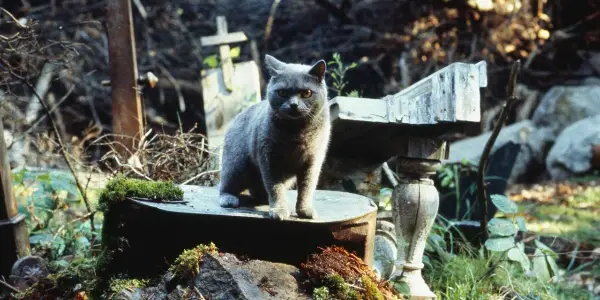
Welcome back to the scariest, and at times goriest, column here at Film Inquiry: Horrific Inquiry. Twice a month, I will be tackling all things horror, bringing two films back into the spotlight to terrify and frighten once more. And occasionally looking at those that could have pushed the envelope further. Join us as we dive deep into the heart of horror, but warning, there will be spoilers.
“The soil of a man’s heart is stonier, Louis. A man grows what he can, and he tends it. Because what you buy is what you own. And what you own… always comes home to you.” – Pet Sematary (1989)
I had a hard time selecting “the film” that would be the perfect choice to close out the month of horrific celebration. Toiling between possibilities, it was the suggestion of Stephen King‘s Pet Sematary that felt like the fitting end to our October horror marathon. It had been years since I had seen the film, and my memory was vague surrounding the details. I had the general premise and the devastating aftermath in mind, but much of the film had fallen into darkness.
Watching Pet Sematary this time around, I was surprised by how good the film actually was. Bad acting aside, there was a deeper intrigue and a more solid cohesion of horror than I had remembered. Where my youth left me remembering the film as a horror of zombies and a demonic afterlife, this time around delivered a fascinating examination on the obsessive nature of humanity to control life and death, defying nature to devastating effect.
A Foreboding Close Call
Pet Sematary opens on the cemetery itself, Elliot Goldenthal‘s eerie score meeting the ominous notes of an unseen choral arrangement. The opening holds both a sense of foreboding and humor as the camera panes over the makeshift tombstones that have stood the test of time. Heartbreak emits from the numerous markers, but the warmth and humor of love keeps the audience from being weighed down early on as they read the testaments left in the wake of loss. The opening is not in a rush to move itself along to its central focus, giving us time to take in the amount of deaths, the numbers met with explanation as the film transitions to the road that has claimed many of their lives.
source: paramount Pictures
Pet Sematary is a film navigated by the trucks constantly soaring by. Their speed is matched by their size, the combination speaking to an almost unstoppable power and brutality. Honestly, in essence it creates the perfect metaphor for the unstoppable power of nature. Throughout the film, viewers will be witnesses to the trucks racing past the home of the Creeds, each truck passing ticking down the inevitability of what is to come. Even at night, in the safety of their home, the sound of trucks racing by engulfs the Creed family, working as a constant reminder to the danger that lurks just outside their home. The trucks evolve into a constant catalyst for the defiance of nature, an unstoppable motion put into action.
For the Creed family, there is nothing but pure joy as they arrive from Chicago to their new home. However it is short-lived as Ellie (Blaze Berdahl) runs for the tire swing, falling as the branch breaks. As Louis (Dale Midkiff) and Rachel (Denise Crosby) tend to her, they fail to notice their son Gage (Miko Hughes) moving towards the road – all while a truck comes barreling on. And while you may know the death of Gage is on the horizon, the film is not yet ready for that kind of devastation, working slowly to its endgame one step – and one death – at a time. In a last-minute save, neighbor Jud Crandall (Fred Gwynne) saves the little boy, his relief accompanied by a warning for the dangers the road holds.
Are you ready for Death
Pet Sematary work the filming its characters over time, the Creeds settling into their new home and crafting a strong friendship with Jud next door. Yet it also begins to set its pieces in place for the increasing experiences of death. As Jud and Louis talk of Pet Sematary at the end of the path, Jud attributes the loss of a pet as a means for a child to come to understand death. There is a wisdom the emanates from his words, yet a coy knowledge of something deeper tucked away until absolutely necessary to reveal.
source: Paramount Pictures
The first death the film delivers is that of a Victor Pascow (Brad Greenquist) – a patient hit by a truck that is brought in to see Louis. He tries to save the young man, but finds he is unable. The loss appears to hit him deeply for a doctor who we can expect has seen death a time or two. Yet, the attempt he made to save the young man draws him back, Victor determined to save Louis. That same night, the ghost of Victor appears, leading Louis to the Pet Sematary, warning him never to cross the barrier. Now, honestly, it leaves the question of whether Victor could have ever stopped Louis, his warning only heightening the curiosity and potential violation of nature. It can also be argued that Victor works to keep the nature of things in order, bringing those to their end in an attempt to restore balance.
Victor’s warning falls on deaf ears however, Rachel and the children traveling to Chicago for Thanksgiving, Louis hanging behind. Jud alerts him one morning that their cat, Church, has died having been hit by a car on the road. Louis seems ready to accept the cat’s death, but visibly struggling with the future task of telling his daughter that Church has died. Jud feels his pain, taking him to the Pet Sematary and beyond the barrier, showing him an ancient Indian burial ground. As he instructs him to “bury his own”, Jud’s emotions cloud his judgement, agreeing that Ellie is too young to experience the loss and death of a loved one.
It is later revealed that Jud knew of the burial grounds because he too buried his dog Spot there, unable to let his dog go following his death. And like Spot, Church returns, smelling of death and feeling demonically changed. As Jud warns that sometimes death is better, there is a relief that Ellie has been spared the loss of her cat. The film works well on increasing the levels of death in these characters’ lives, tackling the death of a stranger, then the death of a pet before striking its trifecta with the death of family.
source: Paramount Pictures
In this moment, we as viewers come to understand, no matter what introduction or experience we may have with death, we can never truly be prepared to lose the ones we love. For the Creeds, a sunny day of kite flying is shrouded in darkness as Gage walks into the road and is hit by a truck. As his bloodied shoe bounces down the road and Louis screams into the void, Pet Sematary takes on who new level of terror and emotional pain.
Defying the Natural Order
By the time Gage is killed, we know where the film is going to go. We know Louis will bury Gage in the ancient burial ground and we know he is not going to return to the Creeds as he once was. Pet Sematary does not immediately dive into the catalyst of Louis and the Creed’s destruction. rather, it allows a moment for the human emotion. We see Rachel struggling with the loss of her son, we see Louis battling with the knowledge of Church’s return and letting Gage go – we see the need to place blame in the absence of understanding. As each of these moments of humanity are entered, the tension grows as each pushes Louis to do the unthinkable.
Believing if something goes wrong he can just put Gage back to sleep, Louis buries his own son like Church, a small hand reaching out of the rocks and towards the night. Honestly, one of the best performances of the film is Miko Hughes as Gage. The laughter is familiar, yet demonic. The face is cute, but terrifying. It amazes me how performances from children this small are accomplished. And Hughes delivers in every way. From dialogue to action, the last third of Pet Sematary belongs to Hughes.
source: Paramount Pictures
After rising from the dead, Gage does not make his way to the Creed home, but rather the home of Jud. In a crescendo of death, the violations of nature are rebalanced. Jud becomes Gage’s first victim as he was the one to show Louis the power to bring the dead back to life – even in the face of the knowledge of what happened to his dog and a local war veteran. His death is quick but brutal and gorier than I had remembered. From a slit Achilles, to a sliced mouth and the jugular ripped out by Gage, I couldn’t help but notice a plethora of homages that have followed in the film’s wake, its inspirations deeper than I had ever appreciated.
While the ghost of Victor has done everything he could to aid Rachel in reaching her husband before it’s too late, it feels as though he has ensured she has reached her death. Rachel’s death is less brutal, leaving her body to work as a moment of a jump scare reveal to the deepening demonic nature of Gage. As Louis makes his way to the home, finding Jud and Rachel, his comprehension surrounding his violations of nature leads him to make the decision to let his son go. Yet, again, there is no amount of preparation that can make one ready for death. Louis shrouding Rachel in a sheet and walking her towards the Pet Sematary becomes the representation of history repeating itself in man’s obsessive need to control both life and death.
Conclusion:
Louis never truly learns or grasps the understanding of defying the laws of nature – and he never learns to accept death as a part of life. There is a deeply grown obsession with controlling nature and changing the course of the demise of those around him. Pet Sematary feels like a good time horror film wrapped in the Stephen King charm, but it is terrors run deep and its implications devastating.
Does content like this matter to you?
Become a Member and support film journalism. Unlock access to all of Film Inquiry`s great articles. Join a community of like-minded readers who are passionate about cinema – get access to our private members Network, give back to independent filmmakers, and more.






